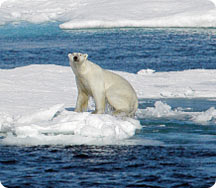
Polar bears live only in the Arctic. They’re the Arctic’s top predatory animal and specialize in hunting down ringed seals. They also feed upon fish, eggs of polar birds, polar foxes and caribou. They may also consume carrion, berries or other plant life when it is accessible. They're the largest carnivorous mammals and belong to the top level of the food chain in the Arctic. By nature they are clever and curious animals and it's this trait which allows them to acquire and eat up anything which impresses them as being unusual or stimulating.
They are native to Canada, Greenland, Alaska and parts of eastern Russia being widely scattered in Canada, from the northerly Arctic islands and south to the Hudson Bay. continued...
Polar bears must wait for the sea ice to solidify each autumn so that they can take up foraging for seals. They use the sea ice for just about all of their intrinsic behaviors, including feeding, sexual coupling, travelling, and gestational denning. They will most often pair off for mating between March and May with a postponed implantation taking place in September or October.
They have no natural enemies with the exception of mankind and other polar bears.
These remarkable creatures are perfectly outfitted for dwelling in frigid Arctic regions, moving on ice and snow, and swimming in freezing bodies of water. They can swim as far as sixty-five to a hundred miles and frequently do.
This amazing animal is one of the few species that are completely adapted to to living in areas with exceedingly disagreeable weather conditions which makes them a unique life form and one which is deserving of our respect, admiration and concern.
Thursday, October 11, 2007
Polar Bear Facts
Posted by
Coffee Blogger
at
12:59 PM
![]()
Subscribe to:
Post Comments (Atom)


No comments:
Post a Comment